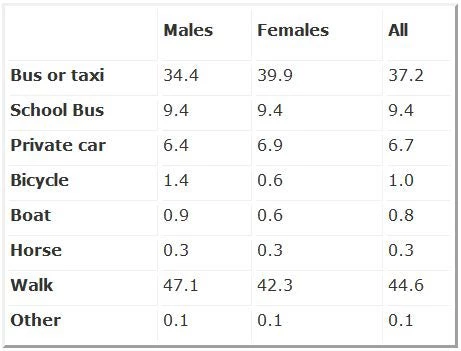A very good panel discussion this week on Gender Equality Data and Tools at the Bank reminded me of the research we did in transport on household surveys with my friend and a World Bank colleague, Kinnon Scott. In retrospect, this work should be better advertised as it touches upon many of the points that were raised on the importance of gender-relevant data for policy. The three main questions that follow permeate the discussion and are of particular relevance for the transport sector as we seek to review our own gender data needs.
What do household surveys tell us about gender? There are four common household surveys that exist in developing countries with data that can provide insights on gender issues—Living Standard Measurement Studies (LSMS), Household Budget or Income and Expenditure Surveys (HBS/IES), Demographic and Health surveys (DHS) and Multiple Indicator Cluster Surveys (MICS). Although not designed to provide specific transport sector data, we used examples of each type of survey to illustrate the extent to which these surveys can contain useful information on transportation. Exploiting such household surveys can be a way to improve transport policy for women without spending considerable additional expenditures on surveys, which are expensive. They offer the additional advantages in that the household surveys are more likely to be repeated—thus ensuring the availability of future data, and governments have made the data sets publicly available.
Links to common Household Surveys:
LSMS: http://www.worldbank.org/lsms/
IES/HBS: http://www.measuredhs.com
MICS: http://www.unicef.org/statistics/index_24302.html and http://www.childinfo.org/mics3_surveys.html
The main findings of the review shows that there is potentially substantial amount of data available across countries on one or two aspects of transportation such as costs and mode used to visit education and health facilities. However, there is little information in the surveys on other important aspects of transport such as mode choice, security and travel patterns.
Can we add a specific gender module to Bank household surveys to help bridge any data gaps? A key recommendation derived from this research can help answer this second question. Among LSMS surveys, the questions will tend to vary because of the heavy customization of these surveys to meet country demands for data. As a result, it may be possible to marginally influence surveys to expand the data collected on gender and transportation. It would be useful if survey questions could be systematized as much as possible in the future to integrate gender considerations in a way to ensure that questions are similar over time within each country. Questions should be simple to implement and allow for comparability across countries. In transport, adding more gender questions could ensure a better focus on gender and transport issues. As evidenced in our recent regional survey work, a standardized approach could be promoted for collecting and evaluating gender data in transport. Substantial background work for developing a standard module has already been carried out and could be expanded upon.
Which key gender indicator should we try to collect data on in the future? Answering the final question is the most challenging and related to the previous one. The relevance of gender data very much depends on the sector and the related data gaps for that sector. In transport, the focus of the analysis centered on aspects of accessibility and transportation choice; affordability; travel patterns and trip purposes; and quality and security concerns. The focus of analysis will vary for another sector.
Mode of Transport to School: Panama 2003

Source: Encuesta de Niveles de Vida, calculations by authors
Sectors and gender specialists will need to work together to provide guidance on which data needs to be more gender-disaggregated or with a greater gender focus based on specific objectives. For example, demographic and Health Surveys (DHS) lists among the eight factors that limit the use of health care the distance and lack of transport and whether any of these factors is a constraint to health care access. Yet, data collected on potential linkages between the health and transport sectors is often not reported or considered for taking steps in formulating policies in favor of improving maternal health (MDG 5).
Finding common ground on data needs is important to move forward. Household surveys that allow disaggregation of household data by gender are costly, both in terms of time and other resources and, therefore, are done infrequently. Agreeing on a definition or common nomenclature for defining what constitutes good and useful gender data will vary by sector. In transport, it will likely rest on defining what constitutes transport accessibility and how related variables linked to investments or policies may influence transport outcomes across gender. However, stand alone transport surveys will continue to be needed to foster the production of gender statistics in transport in developing countries and the incorporation of gender differences into transport decisions.


Join the Conversation